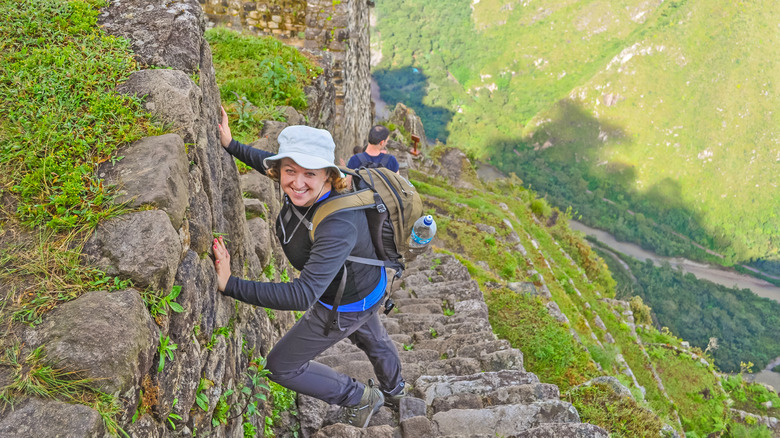Why This Popular South America Trail Is Considered The Hike Of Death
What's the first thing you think of when someone mentions Peru? Is it the cuddly alpacas making their way along cobblestone streets? The mouthwatering ceviche? The vibrant colors of traditional clothing? Or maybe it's the ancient Incan ruins plastered all over brochures and social media? If your answer was "ruins, duh," then you're probably already familiar with the ancient city of Machu Picchu.
Sitting high atop the Andes, Machu Picchu draws in more than 1.5 million visitors a year. With its centuries-old temples and terraces, the globally-renowned UNESCO World Heritage Site is also recognized as one of the New Seven Wonders of the World, and with good reason.
But looming above the remnants of what was once considered the greatest treasure of Inca civilization lies the lesser-known Huayna Picchu, which overlooks the surrounding landscape and provides unobstructed views of the once-majestic citadel. Standing at an impressive 8,835 feet above sea level, Huayna Picchu — a name that literally translates to "Young Mountain" — might not be as famous as its neighbor, but it isn't any less impressive. Home to a religious temple as well as local flora and fauna, the peak promises an unforgettable journey into history and nature. However, the hike up isn't for the faint of heart. In fact, the trail has earned itself the nickname "The Hike of Death." Steep and terrifyingly built right on the edge of a cliff, the trail garnered a reputation for frightening even the most intrepid adventurers.
Scaling to the top of Huayna Picchu
Your adventure to Huayna Picchu starts long before even setting foot on the trail. Due to the site's historical importance and the need to maintain its integrity, only 400 visitor passes are available each day, so pre-planning is needed to guarantee your spot. Your best bet is to book your ticket through the official Machu Picchu website well in advance — especially if you're going during peak tourist season, from June to August. Keep in mind that you'll need separate tickets to visit Machu Picchu and Huayna Picchu, and a double pass for both sites will cost about $52 for adults and $31 for children.
In terms of fitness, the hike to the summit of Huayna Picchu is approximately 1.2 miles one way. And while it might sound like no big deal in terms of distance, it's the steepness — particularly the "Stairs of Death," a steep staircase along the trail with angles of over 60 degrees — that'll have you out of breath. Uneven and slippery when wet, it's important that visitors use caution during the ascent, yet it's also not as dramatic as it sounds. Protected by a handrail at certain spots, and wide enough to help you find your footing, there's not much you really have to worry about during the hike — except maybe not looking down if you're afraid of heights. However, it is also advised that people who suffer from vertigo abstain from climbing.
Other tips for visiting Huayna Picchu
Although there's no certain way to know about its purpose, historians believe that Huayna Picchu might have served as a military center due to its location. Its strategic position overlooking the main city also suggests a significant role in Incan times when certain civilizations were under constant threat of attack. In addition to taking in a birds-eye view of Machu Picchu below you, make sure you check out the Temple of the Moon, a ceremonial temple built inside a cave, offering a glimpse into the spiritual and ritualistic aspects of the ancient civilization.
As for planning your travels, the easiest way to reach Huayna Picchu is to kick things off in Cusco — especially if you're looking to acclimatize so the altitude sickness doesn't hit you too hard. From there, you'll have to travel to Ollantaytambo and then take a scenic 2-hour train ride into Aguas Calientes, the town located at the base of Machu Picchu. Once in Aguas Calientes, you can either hike up to Machu Picchu — a steep ascent that takes about 1.5 to two hours — or hop aboard one of the buses that run from the town to the archaeological site's entrance in just 35 minutes. At the top, the staff will point you in the right direction toward the Huayna Picchu climb. You can also choose to walk the whole way there along the popular ancient trail, El Camino Inca, but we wouldn't recommend this for the faint of heart.


